I have a long history with the Charleston, South Carolina area, beginning when my high school best friend Steve’s dad bought a fixer-upper 35-foot sailboat and had it towed to the Edisto Beach marina on one of Charleston’s inland waterways. I worked a couple of summers right out of high school helping to rehab the boat (which they ultimately took on an 18-month cruise of the Caribbean), and Steve and I spent the evenings and weekends exploring the nightlife and beaches of the Charleston area. A few years later, my wife Beth and I were married in Charleston; in the pre-Weather Channel, pre-cell phone era, we took off on a lark to tie the knot, driving right into an oncoming hurricane. I literally had to wring the water out of the 10-dollar bill I used to pay for our marriage license! We’ve visited and vacationed in Charleston countless times over the years, but never imagined that we’d ever live here.
The surrounding area here has always been known as the “Lowcountry,” which basically refers to the near-sea level topography of much of the coastal area of South Carolina. Adapting to the weather patterns has been a definite transition for me; for example, the week following Thanksgiving, in Georgia (where I came from), the high temperature was in the low 40s. Here, one state away, it was 78 degrees, and that’s pretty much been the modus operandi for the last month or so – it’s either frickin’ freezing here, or you need to turn on the air conditioning. I have the thermostats in the house set to “auto,” so that it alternates as needed between heat and a/c. A new acquaintance that Beth made (a transplant from up North somewhere) complained to her about the weather: “I hate it here! I’ve got ugly Christmas sweaters that I haven’t been able to wear for three years because of the freaking warm winter weather!”
The driving route that I’ve been taking to get from Atlanta to Charleston for over three decades has hardly wavered; I’d take I-20 east to the South Carolina line, then get off on side roads, eventually ending up on South Carolina Highway 61. That route takes you on an hour-long drive through the historic Ashley River plantation area, where much of the distance is bracketed with Spanish-moss-filled live oak trees that often form an almost total canopy over the two-lane road. While driving down Highway 61 (and no, this is not Bob Dylan’s Highway 61!), you get the impression that you’re basically in the middle of nowhere. That impression has stayed with me throughout all these years, until about a month ago when we drove here using our new address to program the GPS for the first time – and it took us down Highway 61 to the new house. It's literally about a mile away from 61; for decades, I seriously thought that the bucolic South Carolina countryside we observed through countless trips along Highway 61 was seriously remote, when it’s actually only a stone’s throw from unbelievable, near-continuous urban sprawl. I was blown away by this – the pastoral, sleepy Charleston I grew to love over the decades has grown by leaps and bounds in the last couple of decades.
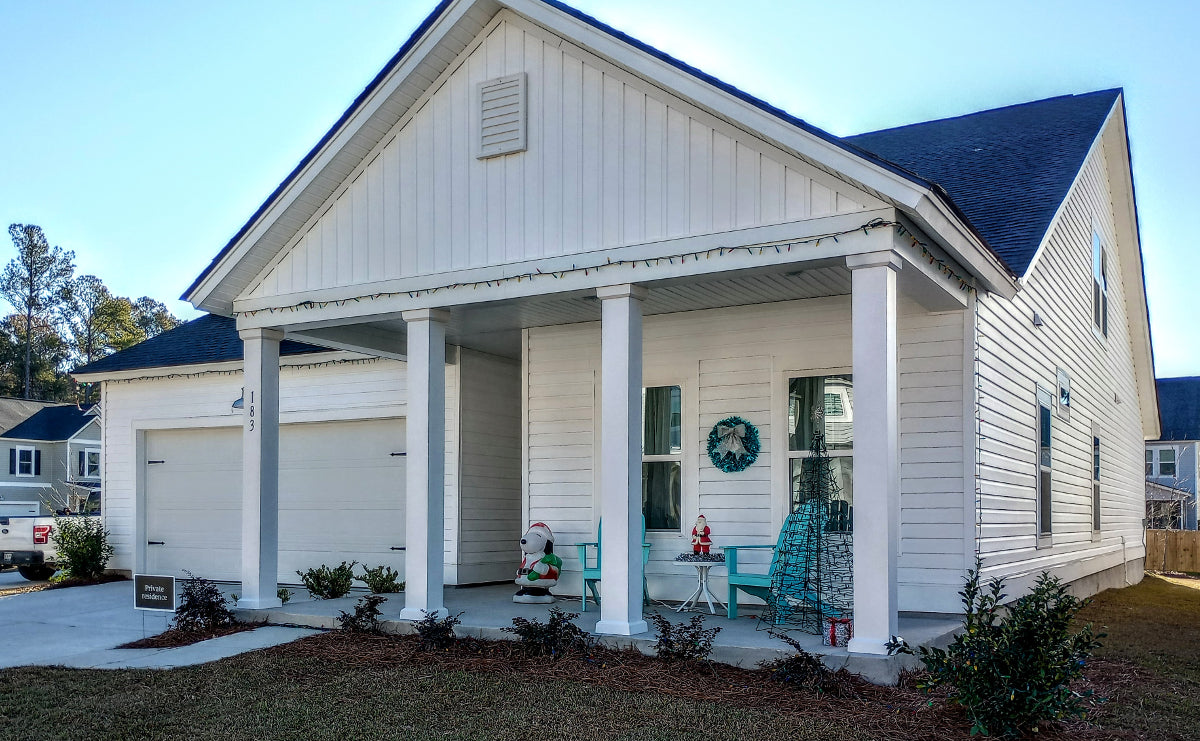 Our new house is fairly traditional-looking, in a fairly traditional-looking neighborhood.
Our new house is fairly traditional-looking, in a fairly traditional-looking neighborhood.The New House, and the New Audio Suite
The new house is actually significantly larger than we thought it would be at the time we placed the contract on it; the plans we saw called for a total square footage of somewhere between 1,797 and 2,100 square feet. It’s actually 2,497 square feet, and some of the rooms are surprisingly larger than we were expecting, including the upstairs audio suite. We found this out on November 17 at our closing – we had downsized and gotten rid of furniture we knew we wouldn’t have room for, and when we moved in, we actually had to acquire some new pieces.
I rented a U-Haul truck with a ramp for the weekend, and Beth and I used a couple of furniture dollies and a hand truck to move everything from our main storage unit to the house ourselves. At two different points, our two-car garage was stacked to the brim with boxes and furniture. One of those weekend afternoons, my son-in-law came over and helped me move the living room and dining room furniture from the storage unit into the house. Unboxing and unpacking went on nearly non-stop (with a few unavoidable interruptions) for about a month. After having spent nearly $10,000 to have everything moved over here into storage, I decided I needed to at least explore attempting to move it into the house myself. It’s been a lot of work, but has worked out well so far at a cost of less than $500 (but countless man-hours!).
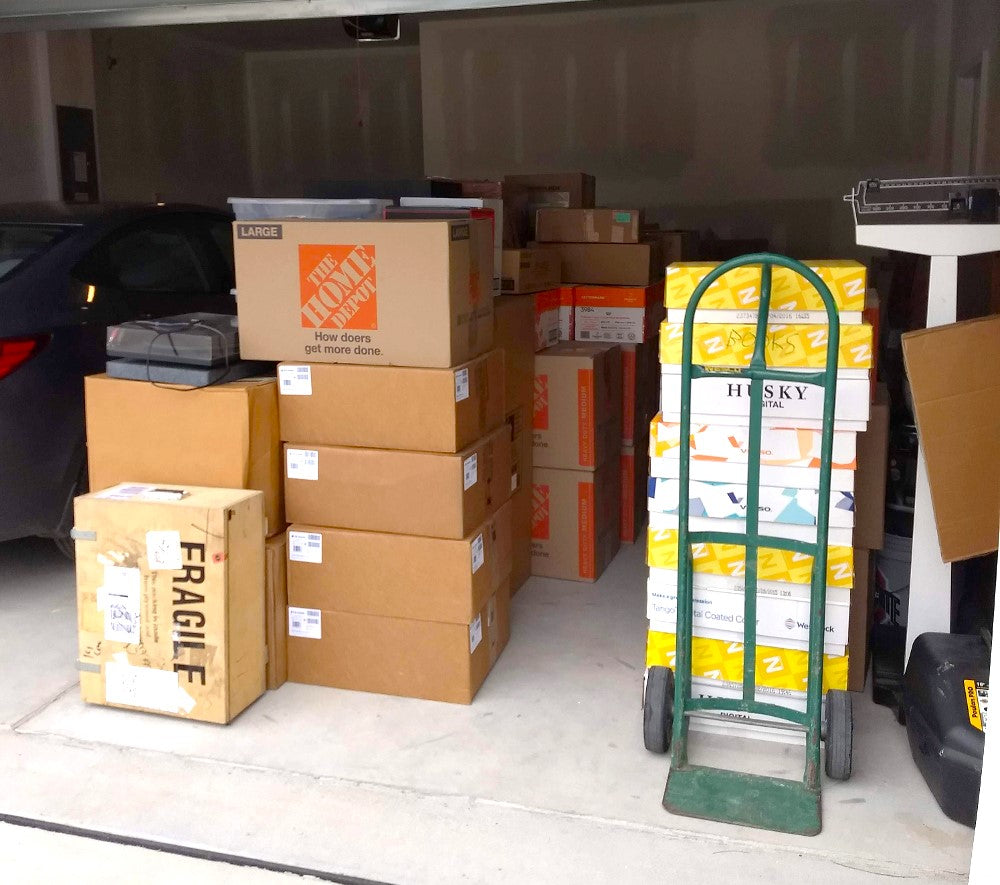 Audio equipment, CDs, LPs, RCA dogs, and Buddhas awaiting the heavy lifting to the audio suite.
Audio equipment, CDs, LPs, RCA dogs, and Buddhas awaiting the heavy lifting to the audio suite.As the unpacking and setup continued seemingly all day, every day, I started taking the evenings to sherpa all the contents of the new audio setup up the long flight of stairs and into the two upstairs rooms and storage areas. It took about a week to get everything upstairs; day one into the process, I went to the local Walmart and bought a knee brace for my left knee, which had buckled while packing and porting boxes into the garage at the old house. The next day, I went back to Walmart and bought a knee brace for my right knee – surprisingly, this worked really well, although my knees ached for a couple of weeks afterwards.
Many of the audio-related boxes were among the heaviest that we moved to Charleston; most of them required unboxing in the garage, then lugging the offending item up the stairs, then carrying up all the boxes. An example: the PrimaLuna EVO 300 tube integrated amplifier weighed over 90 lb. boxed, but only about 72 lb. unboxed. I walked it up the stairs, two steps at a time, resting it on every other stair tread. One of my audio racks weighs 100 pounds; I walked it up the stairs, one stair at a time. Each box of LPs weighed at least 50 lb. or more each – you get the picture. Fortunately, there are two fairly large walk-in closets on the second level of the house, which are perfect for storing all the equipment boxes, etc. And I was able to set up a network workstation in one of the closets, where I can easily manage all my music server backups and file transfers.
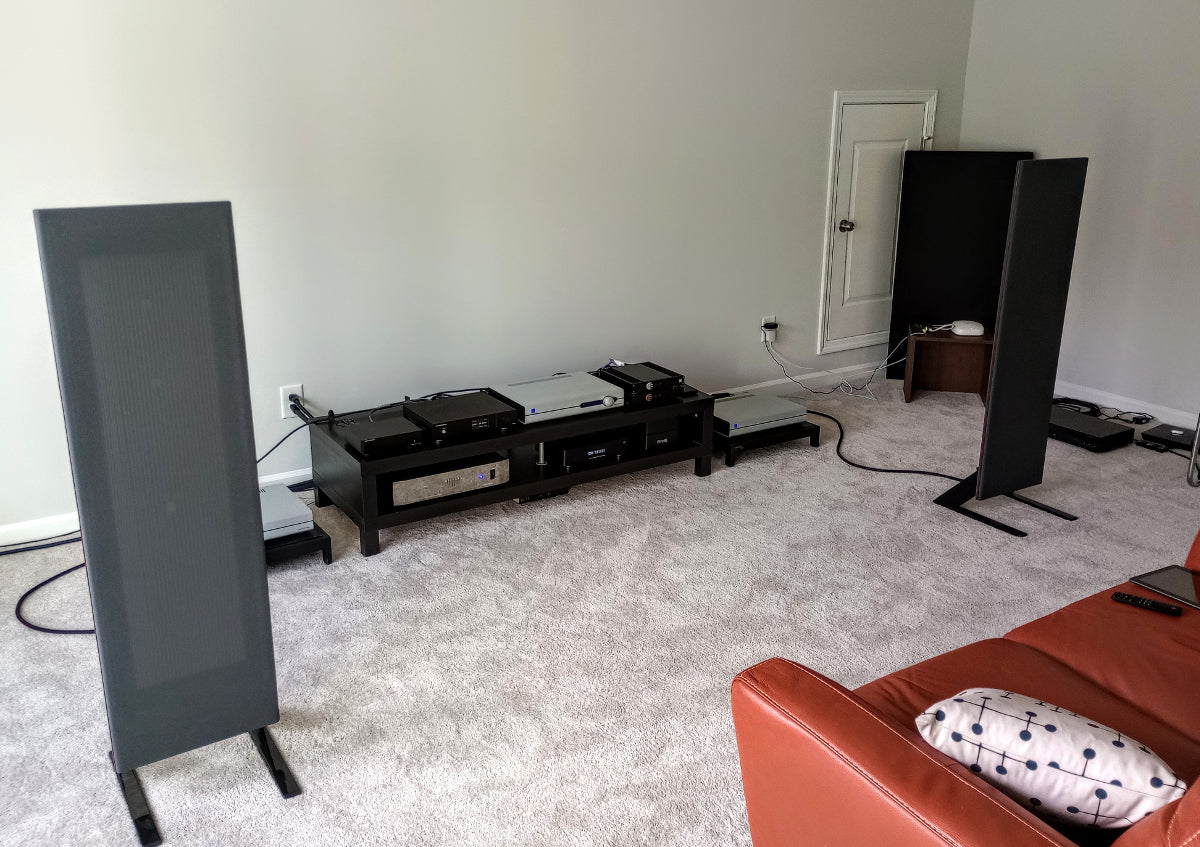 The original long-wall setup experiment was a TOTAL FAIL!
The original long-wall setup experiment was a TOTAL FAIL!It took about a week of evenings to get all the gear, accessories, LPs, CDs, etc. upstairs, then it took about another week to set up and organize the equipment. I had decided to try a new listening arrangement at this location, something I’d wanted to do for a long time, and placed the loudspeakers along the room’s long wall. I then arranged the seating area into more of a nearfield setup. I’d spent much of the six weeks we spent in the dungeon at my brother’s house researching this, but after only a couple of days, I very quickly realized that I hated it. I mean, absolutely hated it. So I moved everything to a more conventional setup, and surprisingly, it sounded pretty great right out of the gate! So I spent about a week of evenings setting up the equipment, then re-setting it up, and then spent several more evenings unpacking all the LPs, CDs and other discs. This went on seemingly forever.
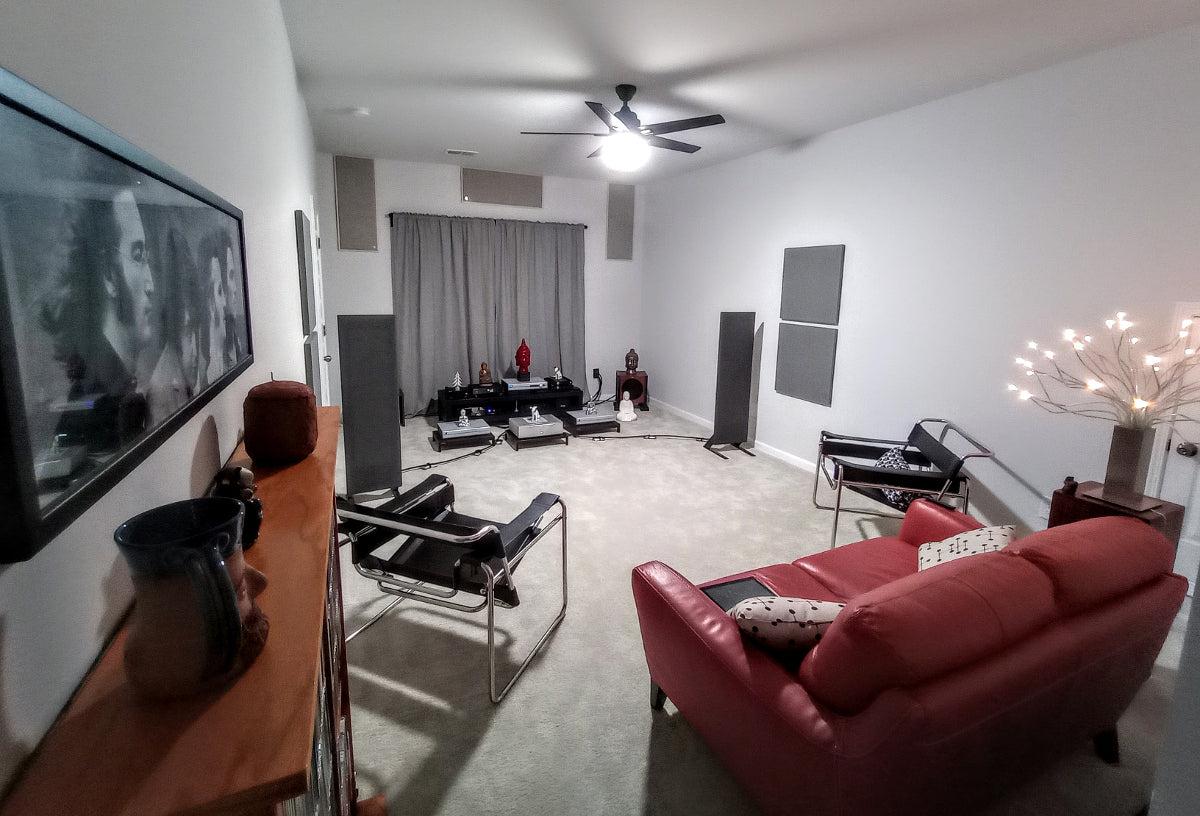 The digital room required judicious placement of acoustic panels.
The digital room required judicious placement of acoustic panels. John, Paul, George, and Ringo watch over the CD collection.
John, Paul, George, and Ringo watch over the CD collection.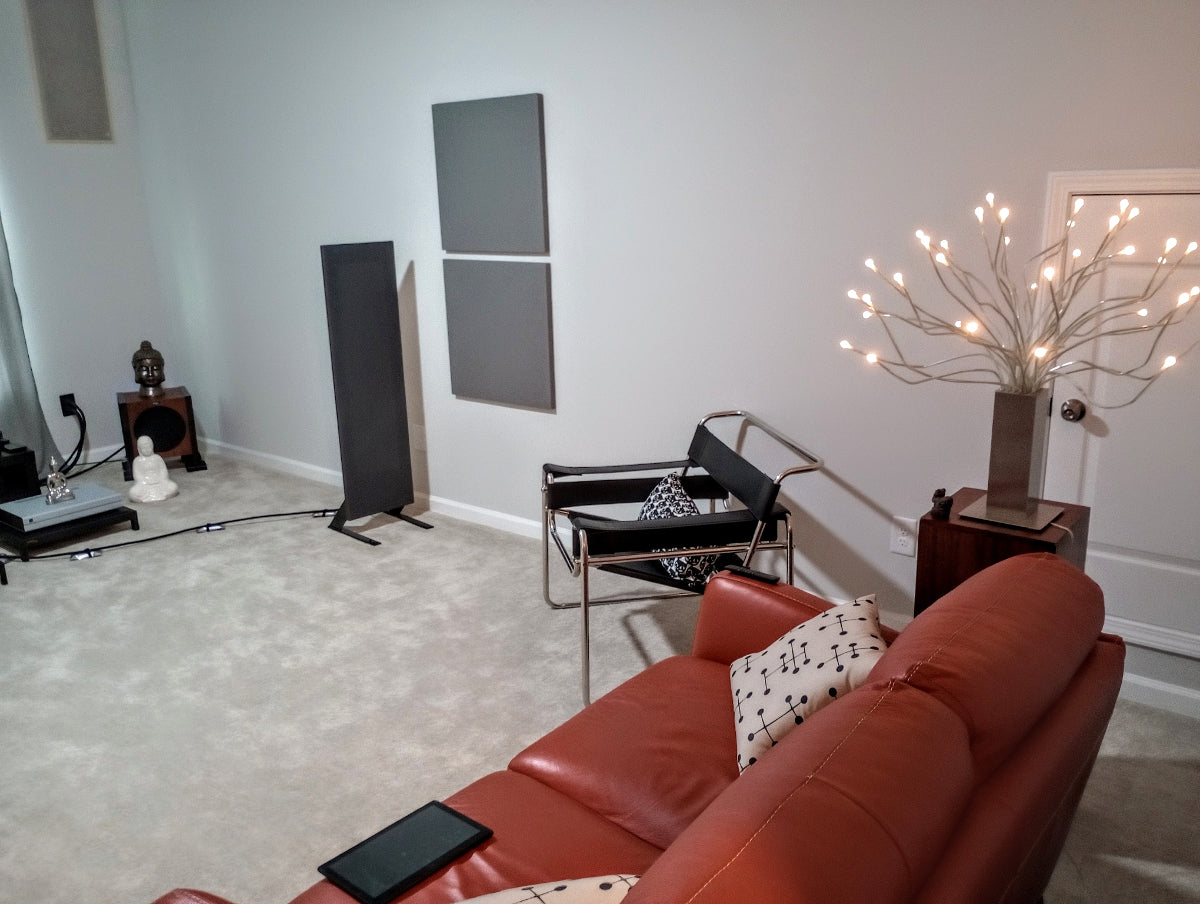 Beth gave me the leather loveseat for the seating area. It's pretty swank!
Beth gave me the leather loveseat for the seating area. It's pretty swank!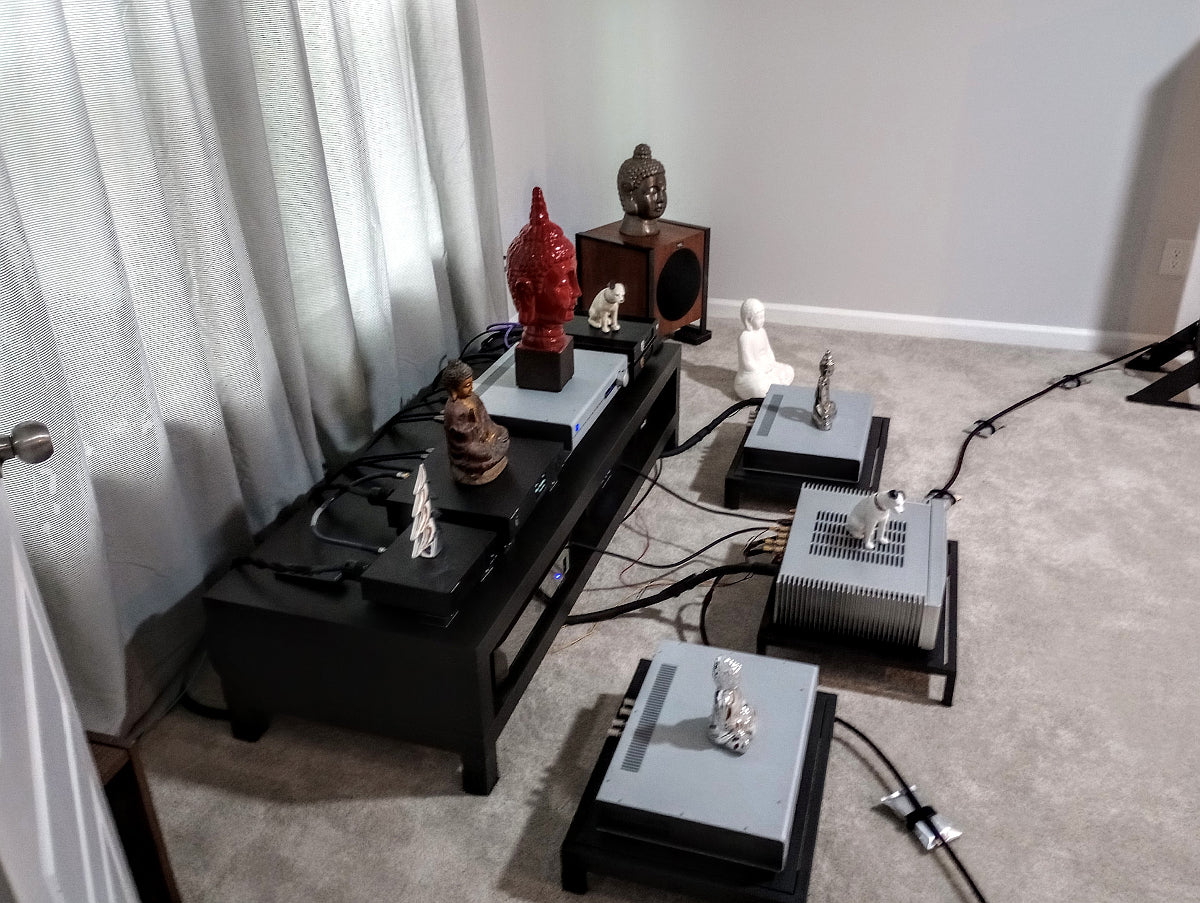 The Buddhas and RCA dogs have made themselves at home.
The Buddhas and RCA dogs have made themselves at home.Thanksgiving, Christmas, and the New Year
Of course, we moved right in the midst of three major holidays, and now having kids and grandkids nearby, the unboxing and setup routines got frequently interrupted, including the need to cook a turkey and all the side dishes on Thanksgiving, then transporting them to my daughter’s house, then all the cleanup and dissemination of leftovers afterwards. Then, of course, there was Christmas; my family’s long-standing tradition (this is in actuality, Beth’s tradition) is that on the day after Thanksgiving, we spend the entire day decorating the house for Christmas.
 Someone was good this year – trust me, it wasn't me!
Someone was good this year – trust me, it wasn't me!The sticky wicket in this scenario was that the Christmas decorations were in storage crates that were buried in the very back of our remaining, yet-to-be unpacked storage unit – which was crammed to the absolute gills. A week after Thanksgiving, we rented another truck, completely unpacked the remaining storage unit to get to the decorations, then loaded them onto the truck, then repacked everything back into the unit. Then we went home for days of setting up all the Christmas decorations, in between more unpacking and normal house setup. It was absolute madness!
 After two-plus years of near-complete caution, we tested positive.
After two-plus years of near-complete caution, we tested positive.Two days after Christmas, I got a call from my daughter – as it turns out, they were all exposed to COVID, and had tested positive. Which meant that Beth and I had also been exposed; we initially tested negative, but three days later tested positive. A solid week of, well, maybe I don’t feel so bad, transitioning to sick-as-a-dog, back to, maybe I don’t feel so bad after all. It complicated and slowed down every aspect of everything exponentially. Happy New Year!
The Realization of a Dream…Well, Sort Of
When we built the previous house, I had this dream of networked automation that would make our cool, custom-designed, mid-century modern home the epitome of smart technology. It didn’t happen; construction cost overruns and other unanticipated problems made that an impossibility. Then a lightning strike happened four months after we moved in; it killed everything electronic in the entire house, and destroyed whatever vestiges of smart home technology that remained. The dream was basically on life support prior to the big crash; after that, it was definitely over.
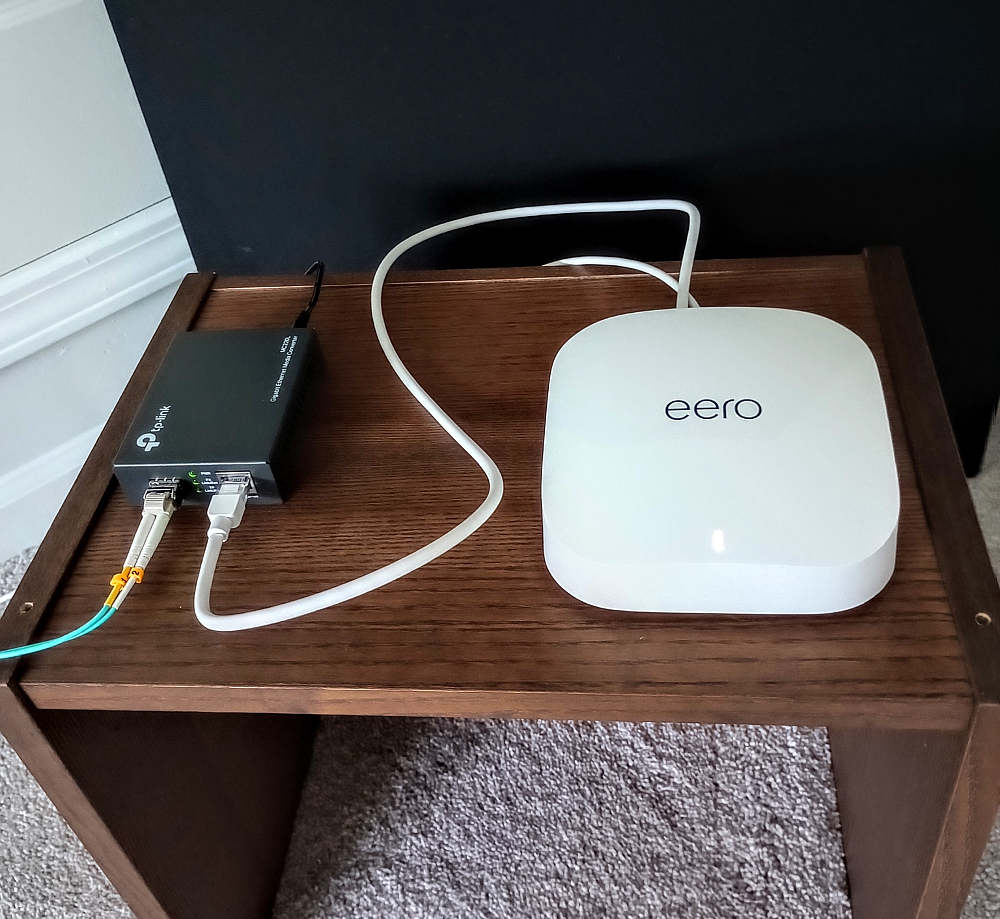 The Eero Pro 6E Mesh system provides seamless wireless and hardwired Ethernet connections.
The Eero Pro 6E Mesh system provides seamless wireless and hardwired Ethernet connections.The builder of the new house in South Carolina, Lennar, is at the forefront of smart, networked technology in their neighborhoods. The house has an Eero Pro 6E mesh internet system, which provides a seamless wireless signal throughout the entire home. There’s a Ring doorbell and motion detection alarm system with multiple cameras, and the Ring is networked with a Level electronic smart lock on the front door and also with the garage door. So I can log into my Ring app on my phone and not only see what’s going on outside the house, but I can also quickly determine if the front door or garage door is locked or open, and then close and lock them remotely if needed. The networked system also extends to our water service; there’s a smart valve that either shuts itself off if there’s a detected water problem, or can be remotely shut off if needed. And the home’s Honeywell thermostat system can be set to automatic, to handle the unusual winter temperature fluctuations here in Charleston, and can also be controlled remotely as part of the smart network. It’s pretty sweet!
Well…mostly sweet, that is. There are a few nagging issues that I’ve yet to resolve. Each smart device has its own app to control it, and the Ring app can be configured to provide system oversight and control of those devices. So far, some of the apps are not really user-intuitive, or are functionally flawed. I’m still working on getting the garage door integrated into the network; the setup appears to be complete, but the door won’t open and close when controlled remotely. The remote control of the front door deadbolt lock is a bit wonky; it can easily be controlled locally, but there’s a nagging issue that surrounds the lock’s internal battery that I haven’t resolved that makes remote control iffy at best. At least I can look at the Ring dashboard and determine that the doors are closed and locked, which provides some peace of mind. A week before Christmas, we had to return to Georgia for several days to retrieve a carload of house plants that were scattered among Beth’s friends while we were homeless during the construction phase. We returned to discover that the deadbolt on the front door had been unlocked the entire time we were gone. Fortunately, nothing happened, but trust me, I wasted no time getting the smart features on the doors and security setup quasi-operational ASAP!
I also got something else I really wanted here; my internet is AT&T fiber, and it’s fiber all the way into the house. There are two important benefits. The download/upload speeds for fiber are nearly symmetrical – right now, I’m getting speeds both ways of 375 Mbps! And with fiber, there’s zero possibility of any of your connected electronics getting zapped by lightning. The cost is only $60/month – for Comcast back in Atlanta, I was paying $50 a month for 50 Mbps down and 10 Mbps up, and it was totally unreliable.
There was one internet-related glitch that took the brilliant guys at Euphony Audio about a day to figure out. The AT&T network gateway also acts as a router, and provides a wired Ethernet connection for the Eero Pro 6E mesh system. When I hooked up the Eero Pro system, I placed one of the devices upstairs in the audio suite to provide a wired Ethernet connection to the Euphony Summus server/streamer stack. I was getting a solid connection to all my equipment, but I couldn’t control the Euphony system with my computer, cell phone, or tablet. Which all appeared to be connected to the same internet source. I ended up taking screenshots of all my connected devices, and the Euphony guys figured out that I actually had two wireless networks active simultaneously at the same time, each with a unique IP address. The AT&T network gateway was in fact a router, and when the Eero Pro device was connected to it, the network then also saw it as a wireless router. Everything that was connected to the AT&T gateway contained a “.1” in the IP address, and everything that was downstream of the Eero Pro unit had a “.4” in the IP address. After re-routing everything that mattered to the Eero’s “.4” IP address, the Euphony system worked flawlessly.
A Work in Progress
The two upstairs rooms that comprise the audio suite have separate performance goals. One is set up with primarily digital source equipment, and the other is driven by mostly analog source equipment. The digital room is the larger of the two, and includes the Magneplanar LRS loudspeakers (which need to have some room to cast an acceptably seductive stereo image), an REL subwoofer, amplifiers from Naiu Labs and PS Audio, preamplification from PS Audio, a DAC and constant-temperature clock from Gustard, and a digital server/streamer/music player stack from Euphony Audio. The smaller room features KLH Model Five loudspeakers, the PrimaLuna EVO 300 tube integrated amplifier, phono preamplification from Musical Surroundings and Sutherland, a Pro-Ject Classic turntable fitted with a Hana SL moving coil cartridge, and a Rega P2 turntable fitted with an Ortofon 2M Mono cartridge. There’s also a Yamaha BD-A1060 universal player for SACD playback (the output is analog, anyway). Both rooms feature power conditioning from AudioQuest, and the vast majority of interconnect, digital, and power cables are also from AudioQuest.
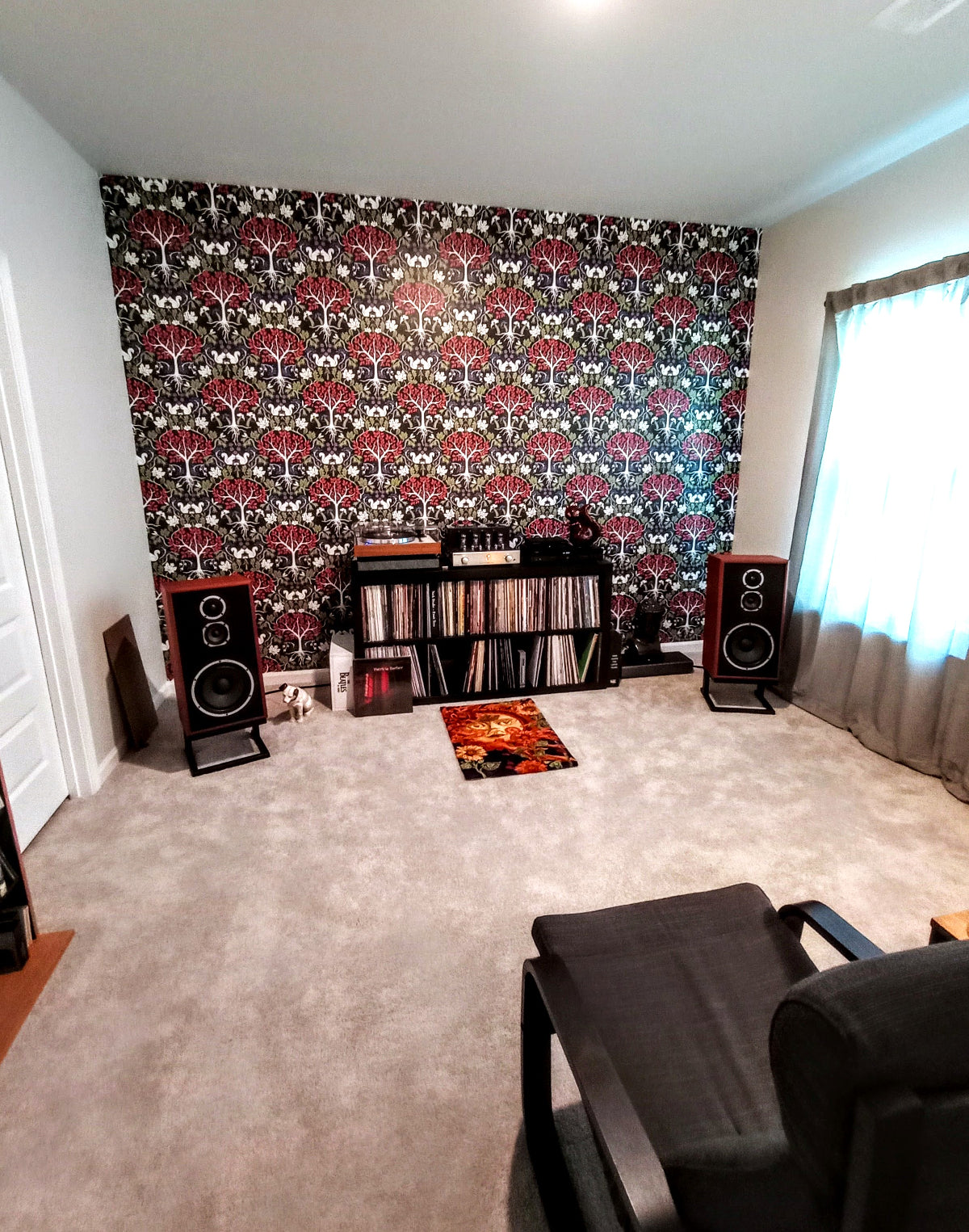 The analog room is still a work in progress, but the sound quality is shockingly good, even without any acoustic panels.
The analog room is still a work in progress, but the sound quality is shockingly good, even without any acoustic panels. I finally decided on this setup for the equipment in the analog room. Love that wallpaper!
I finally decided on this setup for the equipment in the analog room. Love that wallpaper!The digital room is basically complete as is and sounds very good, but the analog room requires more fine tuning. I initially started out with only the Pro-Ject table, and planned to get rid of the Rega, which is the single oldest piece of kit in my entire setup. But that hasn’t happened, and I seem to have a growing collection of mono LPs, so I decided to keep it at least for the time being, adding it to the setup earlier this week. I like the sound of mono LPs when played through a true mono cartridge, but I don’t know if I’m ultimately going to make that a part of the current system. I’d love to score a turntable with interchangeable headshells – that would make indulging my mono fascination much more doable. I still haven’t taken the time to hang any of the Owens Corning fiberglass acoustic panels I have for this room, but I just hung the really cool mid-century modern wallpaper I bought prior to the move. I think it really warms the room up a lot! I may end up moving the Rega turntable to the bigger room.
The two rooms are the first I’ve ever used for listening environments that have windows in them, and I was afraid that might be a problem. On a trip to Ikea prior to our departure for South Carolina, I spotted the curtains I have in each room – they’re specially woven to provide diffusion. Yes, go ahead and laugh, but amazingly enough, they actually work, and curtains for both windows only cost about $100. Hearing the rooms both with and without the curtains is like night and day – I figured I was probably throwing my money away, but hey, it worked out. Like I said, it’s still a work in progress; more to come in the near future. Till then, happy listening!
All photos courtesy of the author except the header image, which is courtesy of Wikimedia Commons/Mr. Matté.













0 comments